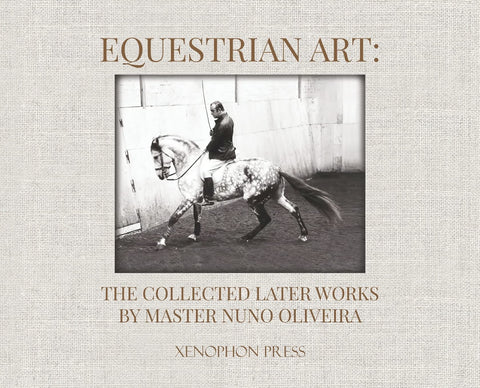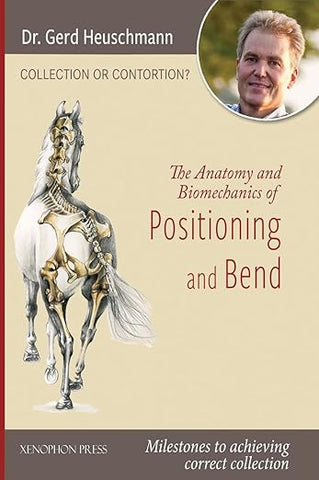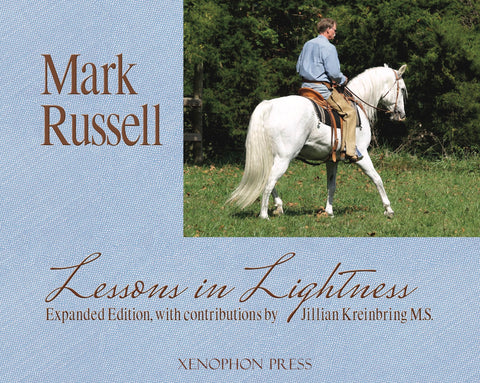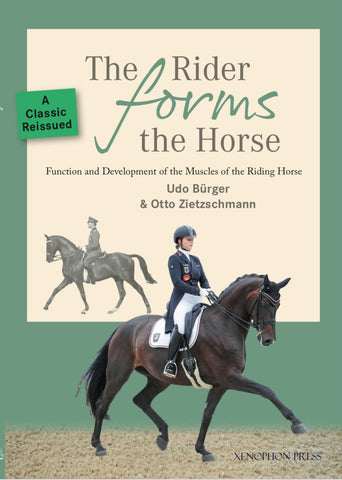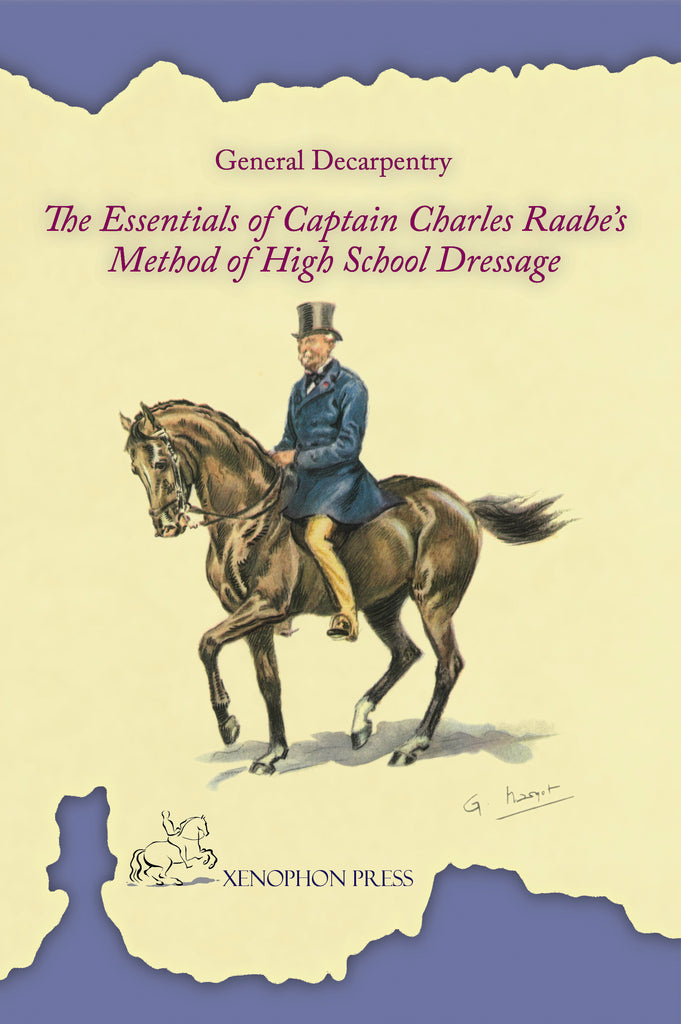
The Essentials of Captain Charles Raabe’s Method of High School Dressage by General Decarpentry
NOW IN STOCK-ALL ORDERS SHIPPING IMMEDIATELY
first ever English translation
The Essentials of Captain Charles Raabe’s Method of High School Dressage, written by Albert Decarpentry, and now translated to English for the first time by Richard F. Williams, brings to light one of the great treasures of classical equitation. Raabe is best known for codifying the work in hand with the whip, a clear and systematic method to supple the horse and prepare it for piaffe. Step by step, his approach develops balance, lightness, and responsiveness, leading naturally to the airs of high school. Decarpentry presents Raabe’s insights with clarity, showing how this tradition values harmony, soundness, and respect for the horse. This timeless work is an essential guide for riders and trainers seeking to understand the foundation of classical dressage.
"Raabe’s Method of High School Dressage (1863) is the most complete and detailed work ever written on this subject in our equestrian literature. It is a valuable guide for riders who wish to undertake the study of artistic equitation."
-General Albert Decarpentry
"With this translation of Albert Decarpentry’s summary of Captain Charles Raabe’s method, we bring to a close a work that bridges centuries of French equestrian thought. What Raabe codified in the mid-19th century—under the influence of Baucher yet with his own rigor and originality—was not simply a collection of technical devices.
It was a philosophy of training that sought clarity of aids, precision of execution, and above all, harmony between horse and rider. Decarpentry, writing in the 20th century, recognized Raabe’s importance as more than a footnote to Baucher. He saw in Raabe’s pages an indispensable key to understanding how the Baucherist system evolved, and how the concepts of effet d’ensemble and rassembler could be applied, distinguished, and alternated with intelligence. In preserving Raabe’s lessons, Decarpentry ensured that this finely articulated knowledge would not disappear into obscurity, but remain available for riders and scholars seeking to trace the lineage of haute école dressage.
For today’s reader, this translation offers both technical instruction and historical insight. The exercises and distinctions described here—whether in the use of the whip for work-in-hand, the refinement of piaffe, or the delicate balance between restraint and animation—still resonate with the challenges faced by any rider striving for lightness and collection. More importantly, the text reminds us that classical equitation is not static. It has always been a living dialogue: between Baucher and Raabe, between Decarpentry and his contemporaries, and now between the past and ourselves.
As publisher and translator, my hope is that this English edition will give Raabe’s voice its rightful place alongside the masters of classical dressage. It is a voice that insists on discipline, nuance, and respect for the horse’s nature—qualities as vital in our own century as they were in his. May these pages encourage riders not only to reproduce the mechanics of the high school, but to embody the spirit of suppleness, balance, and brilliance that defines the French tradition at its best."
Richard Williams/translator
Excerpt:
"Biographical note:
CAPTAIN Charles RAABE
"Within the pléiade of Baucher’s disciples, Captain Raabe is one of the most remarkable personalities, and surely counts among the most original figures of this School—which indeed did not lack for them.
A rigorous theoretician, a remarkable practitioner, he was one of the pillars of the new equestrian church, both through his writings and through his practical teaching. A ruthless critic, a fiery and sarcastic polemicist, he dealt the method of Count d’Aure the most severe blow it ever received, to the point that contemporaries believed the
publication by Captain Raabe of his Examen du Cours d’Équitation de Monsieur d’Aure was the principal reason for the resignation of the Chief Riding Master of Saumur.1
Moreover, Raabe studied equine locomotion with remarkable perspicacity, and he established a theory that places him in the foremost rank of masters of hippology. When, fifty years later, chrono-photography was able to provide, on the mechanism of the gaits, series of irrefutable documents, they confirmed the accuracy of most of the observations Raabe had made with nothing more than the aid of his eyes, and the soundness of the deductions he had drawn from them.
Raabe possessed a lively and profound intelligence. He carried analysis to the point of minuteness, and one might reproach him for being more of a reasoner than a logician. The stubborn rigor of his deductions sometimes led him to risky conclusions, of manifest
exaggeration. To his very Alsatian tenacity, he joined a wholly Norman subtlety. In discussion, nothing disconcerted him. He often brought forth peremptory arguments, but in their absence, he would find unexpected ones that disarmed his opponents.
Lenoble du Teil, officer of the Haras and later Riding Master at the École du Pin, one day pointed out to him the meager advantages and serious dangers of the use of the spur by ordinary riders to halt the horse—as Raabe prescribed.
1 The Ministry of War did indeed inflict thirty days of confinement on the author of the Examen, but it became known that the Emperor had had the work purchased for his private library, and Count d’Aure took offense.
— “And if the reins should happen to break?” replied the Captain. He was an excellent officer, and his squadron served as a model for all those of the French and English cavalries during the Crimean campaign, which he saw through from beginning to end. His
rebellious character harmed his career, and alienated him from many of his superiors, so much so that it took him ten years to win his epaulette.
A general, a poor and pretentious horseman, had pressed him to consent to train his horse, which kicked at the leg. Raabe had been riding the horse for only a few days—at hours when the general’s visits, prodigal in importunate recommendations, were least to be feared. Nevertheless, he was surprised by one such visit in the midst of his work, and the general insisted on mounting the horse to judge its progress. Raabe, who dreaded the incoherence of his visitor’s aids and the perpetual wavering of his spurs, tried in vain to dissuade him.
While Raabe was dismounting, the horse caught the scent of his master, who cried out triumphantly: “You see, he recognizes me!”
A few minutes later, at a clumsy nudge of his spurs, the general was sent tumbling into the sawdust of the arena, and, while brushing him off with the greatest respect, Raabe could not help but say to him: “You were right, my General, he surely did recognize you.”
His caustic wit spared neither his comrades, who nevertheless held him in great affection for his innate kindness and his proven frankness. When he was president of the lieutenants’ table at Lunéville, an officer of the regiment one day brought his father to the mess. The man was a farmer from the area, in town for business, dressed like a countryman on his way to market. This attire, and perhaps also some small lapses in table manners, provoked barely concealed smiles from certain young officers, who, in Raabe’s opinion, had shown too little deference to the father of one of their comrades. He said nothing at the time, but some days later Raabe himself brought a guest, in somewhat severe bourgeois dress, though of irreproachable correctness, towards whom the lieutenants vied in courtesy and attentiveness, although he maintained a slightly awkward reserve.
At the end of the meal, the president called for silence, as is customary at officers’ tables, and in a loud voice declared: “Gentlemen, let us raise our glasses to the health of the executioner of Nancy!” In fact, he had discreetly made arrangements with the headsman of the département, had lured him to Lunéville under a pretext, and invited
him to dine at the mess.
At their president’s words, the officers were utterly stunned, and their amazement soon gave way to embarrassment. The lesson was not lost on them. To appreciate its full force, one must recall that at that time the executioner inspired in everyone an aversion bordering on horror, and was, in a way, excluded from all classes of society.
In 1842, Raabe went to Saumur to follow the course for instructor-officers, which then lasted two years. He had already at that time received a first introduction to Baucher’s method, but second-hand, through an officer of his regiment, the 6th Lancers.
Throughout his course, Raabe’s riding master was Mr. Rousselet, who was at first hesitant about the value of the new method, but who became its determined adversary once he had seen it applied at the School by the Chief Riding Master, Commandant de Novital.
Raabe’s division did not take part in this experiment, but he observed it with passionate interest, as far as his schedule allowed. Unlike his instructor, Raabe became an enthusiastic supporter of the new method, though this did not prevent him from retaining the most respectful affection for Commandant Rousselet.
At the close of his course, Raabe was placed by the School on the list of officers eligible to be recommended to the Minister for the post of Assistant Riding Master, but this recommendation went no further.
It is likely that his ardent Baucherism contributed in part to this. On leaving Saumur, Raabe used his end-of-course leave to go to Paris to take lessons directly from Baucher, of whom he quickly became one of the best pupils. Returning to his regiment, he
practiced the method with fierce determination, and gradually adapted it to the particularities of his equestrian gifts and his personal aptitudes for training. He was of extremely tall stature, almost out of proportion, and he readily made jokes about it himself. Once transferred to the dragoons, he claimed that the crest of his “pumpkin,” as the copper helmet of that branch of the service was then nicknamed, “rose 2.10
meters above sea level.” He had a very short neck and torso, and legs so long that he could not use the standard model of stirrup leathers. For this reason he had to ride constantly without stirrups during his two years at Saumur. His solidity in the saddle, already considerable, naturally increased all the more, and, it is said, no jumper at the
School managed to unseat him.
The length of his legs, however, had a serious drawback. It forced him to bend them excessively, raising his knees, in order to bring his heels into contact with the horse’s flanks. His seat lost much correctness from this. His arms were also very long, and this physical disposition no doubt contributed in no small measure to the extraordinary skill
he acquired in work on foot with the aid of the whip.
Raabe was a born trainer, and the teaching of Mr. Rousselet—who, according to the students, “knew how to speak the language of horses”—must certainly have further developed his ability to make himself understood in training. His riding skill was matched by a virtuosity with the whip that has certainly never been equaled. This example gives some idea:
Around 1885—Raabe was then nearly seventy-five—the mare Soucoupe, discharged from the cavalry for viciousness, traversed the riding hall at a collected canter, executing flying changes of lead at every stride, held in hand by Raabe, who walked beside her at the level of her shoulders, keeping pace with his long legs. With one hand above the saddle he held both the curb reins and the whip, which he alternately laid on one or the other haunch.2
2 This took place in one of the riding halls of the War College, where Raabe
had obtained authorization to give lessons through the intervention of
Infantry Commandant Bonnal, professor of tactics at the School, and his
best pupil in equitation.
The principles of Raabe’s method are those of Baucher, and he recalls
this repeatedly in each of his numerous works. In practice, he introduced very important modifications to his master’s procedures. His analytical mind and his concern for precision could not be satisfied with certain rather vague directions of Baucher’s—for example, those relating to the use of the spur, whether as an agent of impulsion or as an agent of relaxation for the jaw and neck.
It is forward of the normal position of the heel at the girth, sometimes even in front of the girth itself, that Raabe recommends the use of the spur to relax the forehand.
For its use as an agent of impulsion, he prescribes applying it behind the normal position of the heels when the legs hang naturally.
The distance between these two positions, very wide at the beginning of training, diminishes with the horse’s progress, but should always remain sufficiently marked so that no confusion may occur in the horse’s understanding. Between these two positions, at the normal place of the legs, the action of the legs and the spur plays only the role of a kind of “attention command,” demanding the horse’s focus, the correction of his balance,
and the preparation of his obedience. It is a warning command.
This differentiation brings into “work with the spur” an element of precision and security which Baucher’s works in his first manner did not contain, and contributes to reducing the dangers of a very delicate practice, in which many of the Master’s pupils had failed. It should be noted, however, that the necessity of such a distinction did not escape Baucher, but he indicated it only in his second manner, at least ten years after Raabe.3
3. It must further be acknowledged that it was only clearly formulated in his
Derniers Enseignements, published by General Faverot de Kerbrech [Methodical
Dressage of the Riding Horse According to the Last Teachings of François
Baucher, Xenophon Press 2010] in 1891—forty years, therefore, after Raabe.
The solution that Baucher gave to this practical question is altogether
different from that of Raabe. It is in the form, and not in the placement of the applications of the spur that the Master introduced the necessary distinction: pressures for relaxation, attacks for impulsion.4
There is no reason to deprive oneself of either of these two different procedures, and every advantage in combining them. Their simultaneous use confirms in the horse’s understanding an essential distinction in his training: attacks behind the normal position of the legs for impulsion, pressure at the girth for relaxation of the forehand.
In this way all confusion is avoided, and the very serious difficulties of “work with the spur” are to a large extent eliminated.
It should also be observed that Raabe employs the relaxing effect of the spur earlier in training than Baucher. It is only when the jaw and the neck have been entirely softened by the hand alone, with the aid of flexions, that Baucher employs the spur in order to render unconditional, instinctive, and inevitable a submission already obtained through the skillful solicitations of the hand. Raabe, on the contrary, in his flexions with the hand, employs the support of the legs, or of the whip in work on foot, to demand a submission which he undoubtedly obtains more quickly than would be permitted by the use of the hand alone.
But this procedure does not have only advantages. The relaxation obtained by the application of the spur at the girth is a sudden, spasmodic release, followed by a complete slackening of the muscles to the point of a kind of atony; whereas the progressive relaxation of the forehand obtained by the nuanced effects of an “insinuating”5 hand leaves the muscles their elasticity, with sufficient tension to maintain the hand’s contact with the mouth—often lost under the action of the spur.
It must nevertheless be recognized that the use of the whip prior to that of the spur, as Raabe recommends, does not present the same drawback, or provokes it only in a mitigated form.
4 By “attacks” is to be understood all discontinuous, intermittent, and brief actions
of the legs, modulated in their frequency and intensity from vibration to sudden
shock, passing through “touches” and “taps.”
5 Subtle: Not explicitly stated, with a meaning that is implied rather than outright.
For example, a “voix insinuante” (insinuating voice) suggests something without
saying it directly. This implies a suggestive hand in lieu of a demanding hand.
- Editor’s note.
There is therefore no good reason to deprive oneself systematically of either Baucher’s procedure or Raabe’s, by adopting one exclusively to the exclusion of the other.
The whip, on the contrary, is a precious auxiliary in flexions, and its use presents only advantages, provided it is judicious. Just as (after prior training, of course) the whip at the chest, as Baucher employs it in his flexions, prevents the horse from stepping backward or crouching under the action of the hand, the use of the whip at the flank, as Raabe recommends, prevents any lateral evasion of the haunches and maintains the horse straight. The application of the whip on the loins or the top of the croup, moreover, has a marked and rapid effect on the overall disposition of the topline muscles:
it mobilizes them, and step by step reduces the contraction of the elevators of the neck, leads to the lowering of the latter, to flexion at the poll, and to the loosening of the jaws.
It is therefore necessary, when faced with each difficulty, to choose with discernment the methods that best reduce it, to proportion their combination according to each particular case, and to employ them with discretion, never losing sight of the disadvantages that
may result from the abuse of any practice, whatever the advantages of its use.
On the other hand, almost without reservation, one may adopt the system of horse education practiced on foot by Raabe with the aid of the whip before beginning training under saddle.
It is virtually without danger 6, and of remarkable effectiveness. Long accustomed to all the manifestations of the man who cares for him in the stable and at grooming, the horse understands much more quickly than under the rider the meaning of the indications he will later receive. Freed from the multiple contractions provoked throughout his organism by the presence and weight of the rider on his back, he finds himself in his natural balance, disposes of all his strength as if at liberty, “harmonizes” the use of his forces, and becomes supple much more rapidly than when ridden.
6 Except, of course, in the case of brutality on the part of the trainer.
But in order for this work to produce all the results that can be expected from it, it is indispensable first to associate in the horse’s understanding every action of the whip with the immediate and reflex triggering of forward movement. Wherever on the horse’s body the whip is applied, it must instantly determine the production of this reflex, upon which must gradually be grafted the other particular effects of the whip according to the region or point of its application: chest, flank, loin, top of the croup, thigh, hocks, fetlocks.
It may be regretted that Raabe did not insist sufficiently on this fundamental necessity. Any prudent trainer will not fail to devote, without stinting, all the time required to secure a frank, energetic impulsion, as indispensable on foot as under saddle for undertaking
anything else in the horse’s education. And if some of Raabe’s pupils were sometimes reproached for “dulling” their horses, who showed themselves a little listless in their obedience, those of the Captain certainly did not lack the most loyal impulsion, of which he gave a brilliant proof in the Crimea.
The Anglo-French cavalry was then bivouacked near Kamiesh Bay, and the officers of the two armies vied amicably in equestrian sport, already highly developed among our allies, and almost nonexistent among us at that time.
A little intoxicated by their successes, the English let appear, though courteously, their conviction of the superiority of their riding and of the forwardness of their horses compared with ours.
Annoyed, Raabe sought an opportunity to restore our honor, and he found it during a ride with a group of particularly “sporting” Englishmen. A long wooden jetty, quite wide but lacking side railings, extended out into the bay, its end standing about ten meters above the water.
While conversing, Raabe directed his horse, well supported between his legs, onto the jetty, where the English horses, after some hesitation, consented to follow his.
When the group had reached the end of the jetty, Raabe halted facing the sea, and asked in his most natural tone: “Who jumps?” Thinking it a joke, the English at first merely laughed; but when they heard the Captain repeat his question imperturbably, they protested at the very idea of obtaining from a horse such an act
of submission.
Then Raabe, with a single attack, launched his horse into the sea. Neither spur nor stick—though not spared—could persuade any of the English horses to do the same.
This exploit nearly cost its author his life, for it was with the greatest difficulty that he was hauled out of the water. His horse drowned, which earned the Captain yet another confinement. On the other hand, the General commanding the English Cavalry presented him with one of his own horses, with the finest of trappings.
Raabe wrote numerous works on equitation as well as on the locomotion of the horse and its artistic representation, and he published various critiques of the works of different equestrian authors.
His works of equestrian instruction are:
• Le Manuel Équestre (1845).
• Le Résumé de la Nouvelle École d’Équitation (1847).
• La Méthode de Haute École d’Équitation (1863).
• La Théorie raisonnée de l’École du Cavalier à cheval (1870).
That which concerns the mechanism of the gaits is:
• La Locomotion du cheval (1863).
And his critical studies include:
• Examen du Cours d’Équitation de d’Aure (1854).
• Examen du Traité de Locomotion de Daudet (1856).
• Examen du Bauchérisme résumé by Rul (1857).
• Examen des traités d’hippologie by Lecoq and Bouley (1857).
• Examen de la Théorie de la similitude des angles by General
Morris (1859).
Finally, Raabe’s observations on the artistic representation of the horse are scattered throughout his various works, and he only presented them as a whole orally, in a course he gave at the Manège Pellier in 1868, for the use of painters and sculptors, aided by a living horse.
Without contesting the undeniable merit and high documentary value of Raabe’s hippological and critical works—and notably of his Examen du Cours d’Équitation de d’Aure—one may affirm that it is to his works of equestrian instruction that he owes his rightful place among the most learned French écuyers, and in particular to his Traité de Haute École, which is without doubt the most complete work written on this subject in French equestrian literature. In his other didactic works, Raabe endeavored, like almost all Baucher’s military pupils, to adapt the new method to the needs of military equitation. It must be recognized that, despite his talent and ingenuity, he did not succeed, and that, in this field, Lieutenant-Colonel Gerhardt came much closer than he to the indispensable simplicity required for the instruction of the rank-and-file rider and for the training of the war-horse."
-Albert Decarpentry, Translation to English Copyright Richard F. Williams 2025

